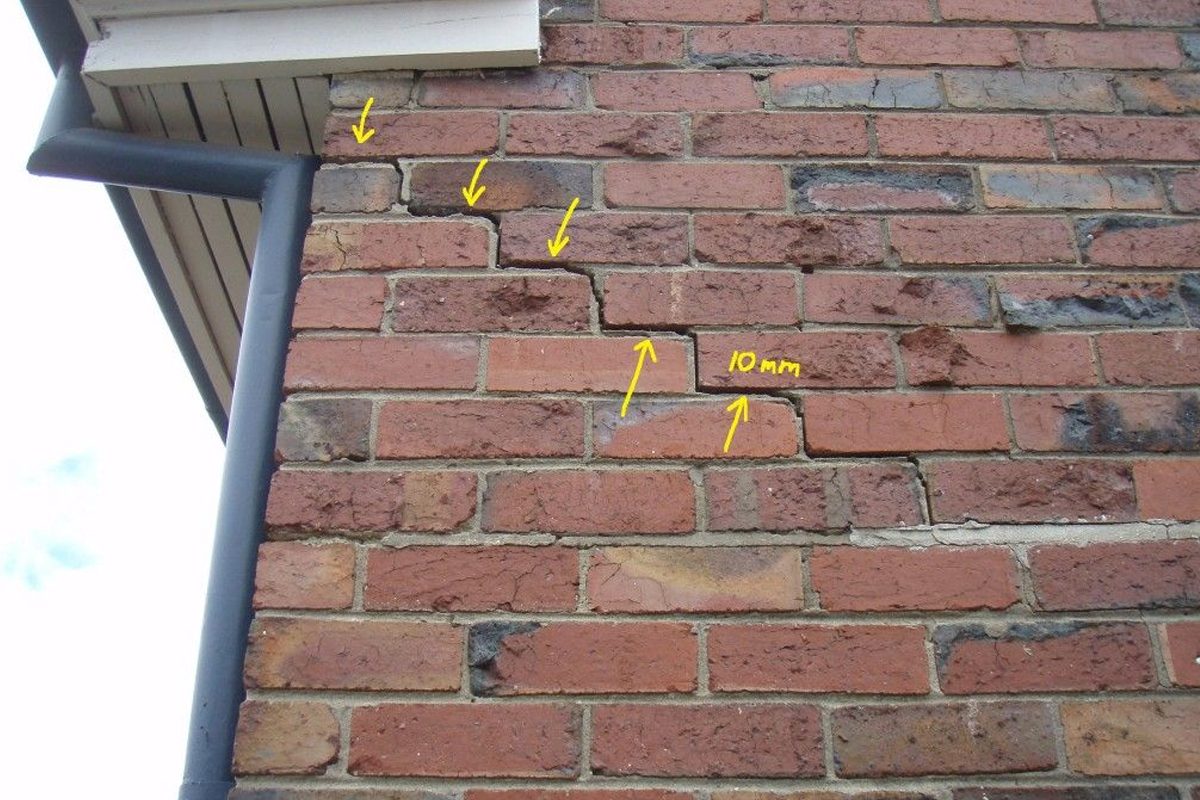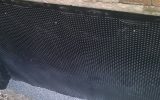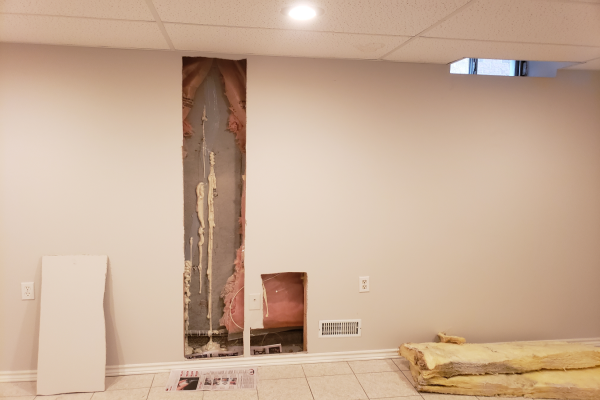Not all of the water that ends up inside your home can be attributed to foundation leaks. The most common sources of basement water infiltration are detailed in the Residential Frequently Asked Questions section of this website. As water is subjected to the force of gravity and takes the path of least resistance, water penetrating the envelope of your home will often manifest itself in one or more of your living areas, but especially your basement.
Water ingress through the building envelope is typically attributable to one or more of the following sources:
• Deck installation, where decks are fastened to the brick veneer using lag bolts to fasten a 2 X 8 board against the veneer (usually over the mortar joint between the top of the foundation and the brick veneer, or above a walkout basement);
• Brick veneer in need of tuck pointing (hairline cracking or deteriorated mortar joints);
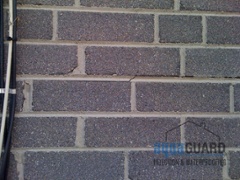
• Window sills in need of tuck pointing (hairline cracking or deteriorated mortar joints);
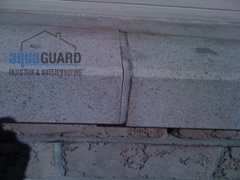
• Brick chimneys in need of tuck pointing (hairline cracking or deteriorated mortar joints);
• Deteriorated caulking around patio door frames;
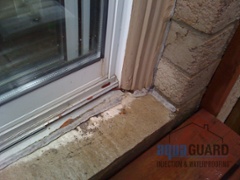
• Deteriorated caulking around window frames, or windows with inherent design deficiencies;
• Plumbing; leaks;
• Roofing and/or flashing leaks;
• Landscaping and/or walkways, or structures installed next to the foundation that are higher than the top of the foundation;
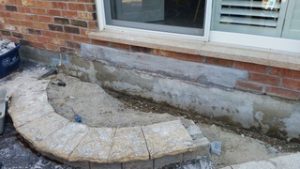
• Deteriorated caulking around exterior door frames, or through the seals around door inserts;
• Interlocking patio stones or flagstone installed on top of the front porch slab;
• Balconies located on the second floor of the home where the balconies are supported by floor joists extending through the brick veneer to the outside; and
• Improperly sealed light fixtures installed in the brick veneer.
Note: Most of these leaks will only manifest themselves when there are driving rains against certain walls of your home (with the exception of plumbing leaks of course). It is for this reason that AquaGuard Injection & Waterproofing® uses thermal imaging and moisture scanning technologies to locate those “hard to find” leaks.
A True Story
In late 2009, AquaGuard Injection & Waterproofing® was called in to locate the source of a leak in the ceiling of the living room on the 1st floor of a 2 story detached home. As we conducted our investigation, the homeowner mentioned that the carpeting in her bedroom on the 2nd floor, directly above the repair, was wet several times during the last 2 years. She recently had the 1st floor ceiling repaired and repainted; the repair was subsequently damaged by water ingress a short time later. She had contacted several contractors prior to calling us and was told by the last one to give him a call when she experienced the problem again, as there hadn’t been any recent precipitation that could lead him to the source of the leak. During our investigation on the 2nd floor, we observed that she had an exterior door that provided access to a balcony. The balcony was supported by floor joists that extended through the brick veneer. We found cracked concrete around each of the joists so we ran a hose up to the 2nd floor balcony and sprayed water, for 10 minutes, on each one of the joists exiting the brick veneer. Simultaneously, one of our technicians scanned the 1st floor ceiling to check if water was entering around the floor joists; no water ingress was observed. We subsequently sprayed water onto the exterior door (from outside…) and shortly thereafter observed that the carpet was wet. The water had obviously entered between the weather strip and the door sill. Then, we sprayed water over the entire door and noticed water entering through the seal around the door insert. Refer to the photos below. After two frustrating years, the source of the leak was finally identified, and the homeowner was very relieved. This is one of the reasons why AquaGuard Injection & Waterproofing® only sends skilled and experienced technicians, not salespeople, to investigate basement water infiltration issues.
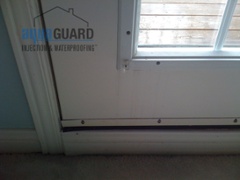
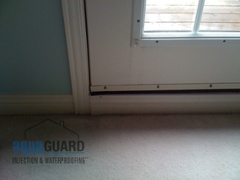
Weatherproofing and landscaping tips:
Weatherproofing
Caulking: It is mandatory that you maintain the caulking around your home to maintain the integrity of the building envelope with respect to water ingress. The caulking around the patio door frame is an absolute maintenance must do. Below is a picture of what can happen when water enters a home around the patio door frame.
Weatherproofing and landscaping tips:
Weatherproofing
Caulking: It is mandatory that you maintain the caulking around your home to maintain the integrity of the building envelope with respect to water ingress. The caulking around the patio door frame is an absolute maintenance must do. Below is a picture of what can happen when water enters a home around the patio door frame.
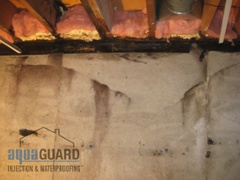
Tuck pointing: Also referred to as repointing, typically involves the repair of weathered or cracked joints in old or damaged masonry. Quite often we hear our customers say that they only get basement leaks when it rains from a certain direction; in many cases, the water enters the home through the brick veneer exterior walls where mortar joints between bricks are in need of tuck pointing. When water enters your home through the brick veneer the water runs down, behind the wall, to the top of the foundation and sometimes travels along the top of the foundation, often resulting in a wet basement.
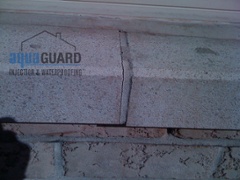
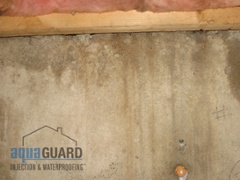
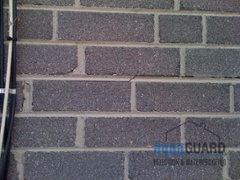
Landscaping
Grade height and slope: You must ensure that you keep hydrostatic pressure away from the wall that is above the foundation. As there is often hairline cracking in the mortar joint between the top of the foundation and the first course of brick, this is an area that is susceptible to water ingress.

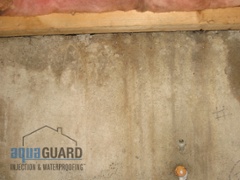
All too often we see landscaping that is too high relative to the top of the foundation. Raised flowerbeds, walkways and patios are often responsible for the introduction of water over the top of the foundation. This type of situation can only be permanently “fixed” by lowering the grade around the foundation (Yes, this means removing and re-installing a walkway or patio at a lower level, relative to the top of the foundation).
Note: Your foundation is built to be underground, your brick walls are not.
CMHC article – Understanding and Dealing with Interactions Between Trees, Sensitive Clay Soils and Foundations
National Research Council article – Basements: back to basics
Swales: Defined as a shallow troughlike depression that carries water mainly during rainstorms or snow melts; it is crucial that you maintain a swale between your home and that of your neighbour. A swale will efficiently channel surface runoff away from the foundations thus reducing the hydrostatic pressure against foundation walls.
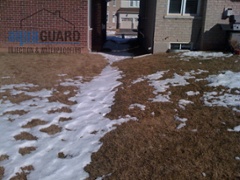
Downspout drainage: It is often published that the downspouts from your eavestroughs should drain water at least 8 feet away from your foundation. An alternative approach (the current construction practice) is to use a splash block which drains towards a swale.
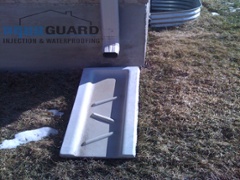
Note: Draining your downspouts into your weeping tile system is not recommended as this will introduce additional hydrostatic pressure against your foundation; furthermore, debris in your eavestroughs may ultimately clog your weeping tile.

